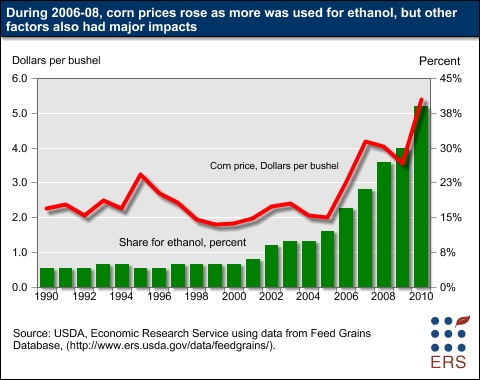Marker blog
Unless you’ve been living under a rock, you know how hot it is outside. This season isn’t like the summers of yesteryear either – temperatures across North America and Europe are reaching record highs. These record-breaking heat waves and insufficient rain has lead to drought conditions in many regions of the US, including the Corn Belt. 23 counties in Wisconsin have already been declared disaster areas. Large swaths of staple crops are unusable, including corn and soy beans. Lower crop yields mean higher food prices, obviously a bad thing for all of us.
So how do increasing food prices relate to alternative transportation fuels? Ethanol. As you probably know, the vast majority of ethanol in this country is derived from corn. Since the ethanol blender’s subsidy expired at the end of last year, the industry has taken quite the hit, and ethanol production has been down consistently while prices for ethanol blends have jumped. But really, corn prices have been high for a while, especially as the crop share used for ethanol production has increased. Check out the chart below:

via fastcoexist.com
The debate about whether diverting corn crops to make ethanol instead of animal feedstock (note that corn for ethanol and for human consumption are two different types) is a sustainable practice still rages on. But with ever-warmer seasons, especially summer and fall, is it really wise to rely on biofuels as an economical alternative fuel source? Probably not, especially since there are other fuel alternatives like propane autogas and natural gas that are already saving drivers money.
If you liked this post, you might also like these posts:
Marker blog
Posted by admin at 6:03PM on 9/1/2011 with tags:
afv, autogas, bev, CNG, corn ethanol, electric car, electric car energy, ethanol, ethanol alternative fuel, EV, food supply, gasoline prices, natural gas, PEV, propane, wind power, wind power cartoon
 Electric vehicles aren’t “zero-emissions” as advertised. Sure, EVs may have no tailpipe emissions, but when an EV plugs in, where does the energy come from? The fact is, almost 50 percent of our nation’s electricity is produced by coal. According to one new study, half of an EV’s lifecycle greenhouse gas emissions are produced during the manufacturing and shipping phase.
Electric vehicles aren’t “zero-emissions” as advertised. Sure, EVs may have no tailpipe emissions, but when an EV plugs in, where does the energy come from? The fact is, almost 50 percent of our nation’s electricity is produced by coal. According to one new study, half of an EV’s lifecycle greenhouse gas emissions are produced during the manufacturing and shipping phase.
- Alternative vehicle fuels aren’t just better for the environment, they’re better for your health. In some states, vehicle emissions constitute the largest source of air pollution like smog and ozone, which can lead to respiratory and other health issues. That’s why the American Lung Association promotes alternative fuel use.
- Current technology cannot affordably harness enough renewable energy power to meet electricity demand. Also, while wind and hydro power are considered by some to be viable energy sources, researcher and author Vaclav Smil contends that these two sources could only supply a small portion of future energy demand. Together, all renewable energy sources only constitute 8% of current worldwide energy supply, according to Smil’s book.
- Biofuels, such as ethanol, are not feasible future energy sources. With the challenges that global food supply is currently facing, we can no longer afford to use food as vehicle fuel while other alternatives are available. Many experts have linked redirected food supply used for producing corn-based ethanol to rising tortilla and livestock feed prices. “Ethanol is taking a larger and larger share of [corn] production,” says one agricultural economist.
To learn more about the differences between alternative fuels, view our Alternative Fuel Fact Briefs online.
PHOTO SOURCE: Project Seed
If you liked this post, you might also like these posts:





